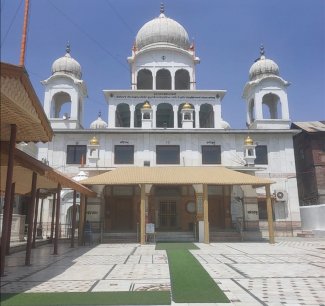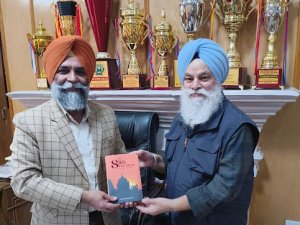Srinagar is the heart of Kashmir. This city has been inhabited since about one and a half thousand years ago.The abbreviation of Sri Nagara is 'Srinagar', which was founded by King Ashoka. At that time its name was Purana Dishthana (Old Capital). Now this place is called 'Pandrethan', which falls within the limits of Srinagar. There is no trace of this old capital, but only the roofs of the Sun Temple, stone carvings, etc. can be seen. Raja Parvag Sena II established his city in 631 AD near the Kohi Maran (hill), which is the center of the present city. He named it 'Parvagapura'.
Lalata-dittya (725-753 AD), a prominent figure in Kashmir history, burnt the city of Parvagpura to ashes. Lalata Dittaya built his capital (Parihaspura) 20 km from the central city of Srinagar. Engineer Soya, a minister of King Avanti-varnam in the 9th century AD, was instrumental in making its lands arable. In 1128 AD, Khan Julchi attacked Kashmir and destroyed the city of Lalta-Ditya with fire. The Muslim kings of the 15th century built bridges with five stone pillars. Many mosques, gardens, forts, bridges etc. were built in the city of Srinagar during the Mughal period (1566-1752 AD). Tourism was at its peak during the Mughal period.Hundreds of small ones around Lake Dal, springs, waterfalls, gardens, parks etc are Shalimar Bagh, Nishat Bagh, Cheshmashahi are very popular. Mohallas GogjiBagh, Wazir Bagh, Alochi Bagh, Ram Manshi Bagh, Badami Bagh, State Bagh, Tang Bagh, Basant Bagh, Magharmal Bagh, Patshahi Bagh and Barzla Baghat are all named after the gardens. During the Afghan period (1752–1829 AD) in Kashmir, Amir Muhammad Sher Khan (1770–1776 AD) built Fort Shergarhi, on the left bank of the Jhelum River, and built the 'Amira Kadal' named after himself nearby. Afghan Governor Atta Muhammad Khan Built a fort in the city of Srinagar in 1810 AD on Kohi Maran. During the Sikh rule, Gurdwara Chatti Patshahi, Kathi Darwazai was built in Kashmir in 1835 on the old plinth.
During the Sikh rule, Maharaja Sher Singh also stayed in Shergarhi for a long time. The Dogra kings (1846-1947 AD) extended Shergarhi fort around their palaces, government buildings etc. and built the secretariat here.From 1947 to 1999 AD, small housing colonies came into existence in the city of Srinagar, such as Bal Garden, Jawahar Nagar, Narsingh Garh, Battamalu, Suthra Shahi, Bemina , Chanpura, Rawalpura etc. During this period, a 17 km bypass came into existence. Srinagar has very important unique historical buildings, such as Shankaracharya Temple, Makhdoom Sahib Building, Kohi Sulaiman, Pandrithan Temple, Sher Garhi Palace, Mulla Akhan Mosque, Sanpatiar Temple, Khankahi Mohalla, Pathar Masjid, Gurdwara Chatti Patshahi, Gurdwara Guru Nanak Sahib Hariparbat. , Mazari Salatin and Tomb of Badshah, Khankahi Bulbulshah, Dargah Hazrat Bal, Pari Mahal, Barandri Mughals, ImamBara, Jamia Masjid, Mosque and Tomb Madin Sahib, Khankahi Naqshbandi, Dastgir Sahib's Ziarat, Akhara Mandir, Gurdwara Singh Sabha Amira Kadal etc.
GURDWARA CHHEVIN (CHATTI) PATSHAHI, Kathi darwaza, SRINAGAR: Gurdwara Chhevin Patshahi Srinagar is situated at the foot of Hariparbat hill. This is the most famous Sikh shrine in Kashmir. Guru Hargobind Sahib visited the Kashmir Valley in the Summer of 1620 C.E. A Manji or the seat of Sikh mission was established at Srinagar in Guru Amar Dass's time. The contemporary masand or the incumbent incharge of the Manji was Sewa Dass. Guru Hargobind rested outside the sealed fort of Mughal City 'Nagar Nargis'. Sewa Dass's old mother, Mai Bhagbhari had sewn a chola (dress) by her own hands, while reciting the holy psalms of Gurbani. She had an intense desire to present this chola to Guru Gobind Sahib personally. It was the magnetism of Mai Bhagbhari which drew Guru Har Gobind to Kashmir. On reaching Srinagar, the Guru met Sewa Das of kathi Darwaza and many more Kashmiri devotees. They received him with great love and devotion. The mother of Sewa Das touched the feet of the Guru. He asked her to bring the chola (dress) she had made for him and put it on. The joy of Mai Bhagbhari was no bounds. The Guru Stayed at Srinagar for nearly three months. He held congregations, delivered discourses and left the place only after he supervised the last rites of Mai Bhaghari and has thus immortalized her.
During Guru Hargobind's stay at Srinagar, Guru ji built a Dharamshala , appointed Bhai Sewa Das its incharge and asked him to live there and preach the true faith.
The Guru rested for a few weeks here but camped sometime at the site of Shalimar Bagh. Regular Dewans were held daily, Guru ji propagated Guru Nanak's teachings. Devotees gathered in large numbers to his message of love and brotherhood. He exhorted them to treat the lowest of low with kindness and compassion.This Gurdwara was renovated by Sikh Governor S. Hari Singh Nalwa (1819-1821 C.E). According to Dr. Sufi "The Gurdwara of Baramulla and outside kathi Darwaza Srinagar were built by Nalwa (Hari Singh)" and also a garden at the Jhelum there. Near the Gurdwara, 'Guru Ka Bagh' is also located. The Gurdwara came under the Gurdwara Act in 1976 C.E, and removed Mahant Shahi after great struggles .Gurdwara Parbandhak Committee Srinagar again repaired and Constructed some parts of the Gurdwara.Now-a-days Kar Sewa Sant Bhai Harbans Singh of New Delhi renovated a splendor Gurdwara at the place of the old one. Later Langar hall and pilgrims' rooms were constructed.
Seventh Sikh Guru,Guru Har Rai Sahib visited the Valley in 1660 C.E.and preached Sikhism. Guru Sahib adopted Jalalpur Jattan, Doburgi, Galotian Khurd, Sialkot route and entered Srinagar, Kashmir. Guru Sahib rested near Hari Parbat hill in the house of a low caste Brahman. This place was earlier Known as 'Sat Guru Devi Angan, Hak Bazar'. Bhai Sewa Dass, Bhai Madhu Sodhi and Ram Garhia, who settled around this place permanently, daily met Guru Har Rai Sahib. This Gurdwara was not traced out until Recently, its mention was made in Tarikh-Kalan( a persian manuscript) and Guru kian Sakhian.Guru Har Rai Sahib spent four months in Kashmir. A huge Jagir associated with Guru Har Rai Sahib Gurdwara as mentioned in Tarikh-Kalan (Persian)is as : Arazi Walaa-212 kanals, Aarowan -213 kanals.
The jagirs granted to kashmiri Sikhs were confiscated by the Dogra rulers. In this way the Jagirs associated with Gurdwara were also snatched. Sikhs were drawn out from the Sringar city and Sikhs sheltered themselves in forests and far flung villages. In this way a number of Granthis (priests) of Gurdwaras also went away leaving Gurdwaras behind. In this way, Granthi Dewan Singh of Chie Guru Har Rai also left. This place was also used as a residential space by Bhai Ramgarhia, Bhai Madho Sodhi who were sent by Guru Amardas and Guru Arjan Dev respectively for the parchar in the mountainous regions of Kashmir. So Guru Har Rai Sahib accompanied by Bhai Dasa and Bhai Arru Ram also stayed here and from here they went to Mota Tanda Where Bhai Dasa (Father of Bhai Makhan Shah Lubana) Passed away. After some time, a small room was constructed at the site of Guruji's stay. After seeing the bad condition of this gurdwara, General Hari Singh Nalwa, gave annual Jagir of Rs 360/- to the Gurdwara Sahib and also attached a lot of lands to this Gurdwara. He appointed S. Hari Singh resident of 'Hak Bazar' Devi Angan as the muntazim of this place. After fall of sikh rule, dogra rulers stopped the Jagir of Rs 360/- and Gurdwara got demolished due to lack of funds and negligence of the community. S. Hari Singh's elder son Munshi Sant Singh brought the historical Bir of Guru Granth Sahib ,which was very old and unique to his home. After his death in 1940 ,Jathedar Lachaman Singh Bonahama got the possession of this Bir and then he regularly performed sewa with proper Maryada and zeal. The bir of Guru Granth Sahib ji is one of a kind written with Kashmiri black ink, on Kashmiri paper with beautiful calligraphy. It dates back to around more than 300 years old. Jathedar Lachman Singh brought this Bir, being very old and handover to the Museum of Central Khalsa Orphanage ,Chief Khalsa Diwan Amritsar , Where it is still kept with proper care and treatment.
GURDWARA PEHLI PATSHAHI , HARI PARBAT,SRINAGAR
After visiting some Mulsim Shrines and Hindu temples, Guru Nanak Sahib stayed inside the Hari Parbat hill. In 1620,Guru Hargobind Sahib laid the foundation of this Gurdwara and is now famous as Gurdwara Pehli Patshahi, Hari Parbat, Srinagar. According to 'Mahan Kosh' this Gurdwara was located later on by some Gursikhs and constructed by Governor of Kashmir S. Hari Singh Nalwa.Granthis were deputed by Sarkar-i-Khalsa Lahore darbar from Rawalpindi and Pothohar.
GURDWARA BUNGA AKALI PHULLA SINGH, SHAHEED GANJ, SRINAGAR
This historic Shrine is situated near Shergarh fort locality. Akali Phulla Singh was the Commander of Akalis and Nihang Sikhs in 1819, when Kashmir was captured by the Sikh forces. This locality was founded by Akali Phulla Singh. During the battle of Shergarhi, Several Sikhs achieved martyrdom. Their last rites were performed at this site. Gurdwara is a modest one, constructed by Akali Phulla Singh. In 1964 Gurdwara was shifted from the basement to the upper room. Gurdwara is managed by the local committee.There are about 6 Sikh families with a population of about 19.
ALUCHI BAGH:
Aluchi bagh is the largest Sikh habituated locality in Srinagar situated on the right bank of rivulet Doodh Ganga. Sikh house holders are about 600 and some tenants also reside with a population approximately 3600.
MAGERMAL BAGH:
Magarmal bagh is in the periphery of Jahangir Chowk. Sikh house holders are 125, with a total population of 935.
JAWAHAR NAGAR :
Jawahar Nagar is hardly 2.5 km from Lal chowk, Srinagar. Total Sikh house houses are 70,many tenants also reside in this area and have about 500 population.
INDRA NAGAR:
Indra Nagar is towards Badami bagh cantt. and is about 2.5 km from Srinagar Lal Chowk.Sikhs reside in Shiv pora, Badami bagh and Amira kadal. Sikhs house
holders are 85,having Population about 300.
BAGHAT BARZALLA:
This locality is situated on the right bank of rivulet doodh ganga. Sikhs reside in Baghat, Rawalpora, Hyderpora and Sheikhpora. Total Sikh house holders are 100 having approximately 386 population.
CHANNAPURA:
Channapura locality is inhabited behind the Baghat Barzalla. Total Sikh families are about 117 having Population 850. It is situated about 4 km from the Lal Chowk Srinagar.
RAINAWARI :
Rainawari is about 4 km from Lal Chowk, Srinagar. Gurdwara Chhevin(Chatti) Patshahi, Kathi darwaza located in this locality. Total Sikh house holders are 34, with approximately 200 population.
H. M. T COLONY:
This colony is 10 km from the Lal Chowk Srinagar. Total Sikh families are 20 and total population is approximately 100.
MAHJOOR NAGAR :
Mahjoor Nagar is situated behind the Jawahar Nagar locality on the other side of the bund. Total Sikh families are 800 having approximately 3000 Population . From Lal chowk distance is hardly 4 km.









